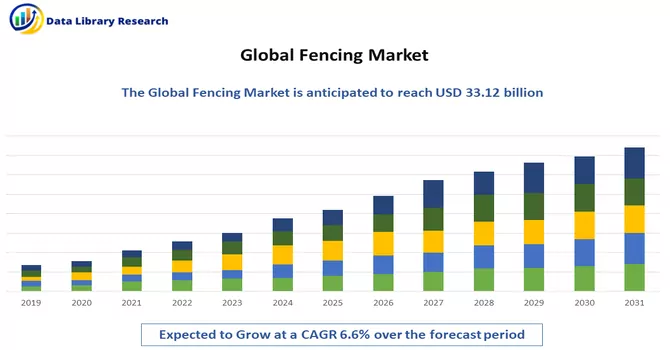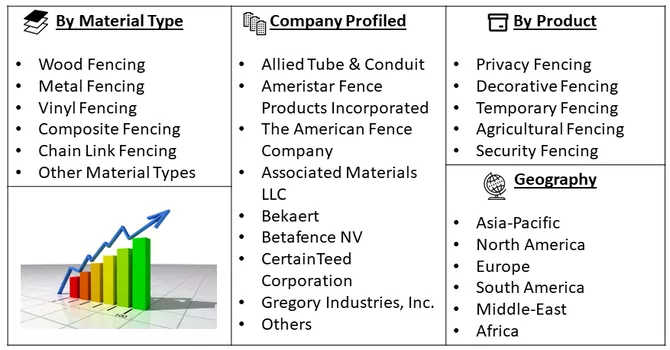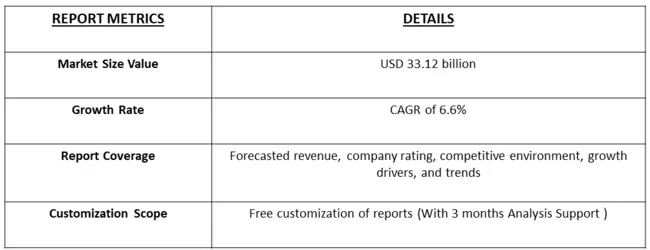The global fencing market size was valued at USD 33.12 billion in 2023 and is expected to grow at a compound annual growth rate (CAGR) of 6.6% from 2024 to 2031.

Get Complete Analysis Of The Report - Download Free Sample PDF
Fencing, in the context of construction and outdoor architecture, refers to the installation of barriers or enclosures typically crafted from materials such as wood, metal, vinyl, or composite elements. Serving a multitude of purposes, fencing plays a pivotal role in demarcating property boundaries, enhancing security, ensuring privacy, and contributing to the aesthetic appeal of residential, commercial, and industrial spaces. Various types of fencing, ranging from traditional picket fences to modern security installations, cater to diverse needs, offering solutions for containment, landscaping, and safety. With considerations for design, material durability, and functionality, fencing is an integral component of landscape architecture, providing both practical and decorative solutions to meet the specific requirements of different settings.
The market is anticipated to experience robust growth in the foreseeable future, propelled by an unceasing surge in new housing construction, home improvement initiatives, remodeling endeavors, and commercial construction projects. The increasing emphasis on safety and security, coupled with the advantageous attributes of lower maintenance costs and heightened reliability offered by contemporary fencing solutions, is poised to significantly contribute to this upward trajectory. As safety concerns continue to drive demand, the market stands to benefit from the ongoing construction trends, offering advanced fencing options that not only enhance security measures but also align with the preferences for durable and easily maintainable solutions in both residential and commercial settings.
Market Segmentation: The fencing market can be segmented based on Material Type (Wood Fencing, Metal Fencing (Aluminum, Steel, Wrought Iron), Vinyl Fencing, Composite Fencing, Chain Link Fencing and Other Materail Types), Product Type (Privacy Fencing, Decorative Fencing, Temporary Fencing, Agricultural Fencing, and Security Fencing), and Geography (North America, Europe, Asia-Pacific, Middle East and Africa, and South America). The market values are provided in terms of USD million for the above segments.

For Detailed Market Segmentation - Download Free Sample PDF
The global fencing market is witnessing significant trends that shape its landscape. A surge in demand for security fencing, driven by safety concerns, is prominent, with modern features enhancing durability and intrusion detection. Manufacturers are innovating with eco-friendly materials and smart technologies, integrating sensors and cameras for enhanced security and remote monitoring. Customization is a key focus, providing consumers with a range of design options. Sustainability and low maintenance are influencing preferences, while the growing residential construction sector globally contributes to increased demand. Notably, e-commerce channels are playing a vital role in product distribution, offering convenience for consumers exploring and purchasing various fencing solutions.
Market Drivers:
Construction and Infrastructure Development
The fencing market continues to thrive primarily due to the substantial expansion in global construction and infrastructure projects. The ongoing development of new residential, commercial, and industrial structures fuels a parallel increase in the need for fencing materials, essential for delineating boundaries and ensuring security. As construction activities surge worldwide, the demand for fencing solutions becomes integral, serving both functional and protective roles in various settings. This growth trajectory is propelled by the essential role that fencing plays in enhancing safety measures and providing a clear demarcation of spaces within the evolving landscape of construction and infrastructure development.
Rising Security Concerns
The escalating apprehensions regarding safety and security, prevalent in both residential and commercial domains, are pivotal factors propelling the demand for resilient and sophisticated fencing solutions. There is a notable uptick in the preference for security fences endowed with contemporary features, including anti-climb designs, surveillance systems, and durable materials. These advanced features are becoming increasingly sought after across a spectrum of applications, underlining the imperative need for protective measures. The heightened demand for fencing solutions equipped with cutting-edge security attributes reflects a growing awareness and a proactive approach to addressing security challenges in diverse settings.
Market Restraints:
Economic Fluctuations
The fencing market is susceptible to economic uncertainties and fluctuations, which can exert a notable impact. In times of economic downturns, the market often experiences a contraction due to a reduction in construction and infrastructure projects. The decreased investment in these development initiatives results in a diminished demand for fencing materials. Economic challenges may prompt stakeholders to postpone or scale back construction endeavors, directly influencing the market dynamics. This cyclical nature underscores the market's vulnerability to broader economic conditions, making it imperative for industry participants to navigate and adapt strategies in response to fluctuations in the economic landscape.
The global fencing market faced substantial challenges during the COVID-19 pandemic as supply chain disruptions, construction slowdowns, and reduced consumer spending impacted the industry. Lockdowns and restrictions led to delays in production and transportation of fencing materials, causing setbacks in construction projects and affecting demand. Retail channels encountered difficulties due to limited customer access, influencing purchasing patterns. Despite these challenges, the market exhibited resilience with a shift in demand towards residential fencing solutions, reflecting changing lifestyle priorities and an increased focus on home improvement. As economies recover, the fencing industry is adapting to new dynamics, emphasizing agility, innovation, and responsiveness to evolving consumer needs.
Segmental Analysis:
Composite Fencing Segment is Expected to Witness Significant Growth over the Forecast Period
Composite fencing offers a host of advantages, making it a preferred choice for modern fencing solutions. Composed of a blend of recycled materials, such as wood fibers and plastic, composite fencing combines the aesthetics of wood with the durability of plastic. One key advantage lies in its resistance to rot, decay, and pests, providing a low-maintenance and long-lasting fencing option. Additionally, composite fencing is environmentally friendly, utilizing recycled materials and reducing the demand for natural resources. It is highly versatile, allowing for customization in terms of colors and designs, and its composite structure makes it resistant to warping or splintering. The durability and low-maintenance nature of composite fencing contribute to cost savings over the long term, making it an appealing choice for those seeking an aesthetically pleasing, sustainable, and resilient fencing solution.
Security Fencing is Expected to Witness Significant Growth Over the Forecast Period
Security fencing stands out as a crucial element in safeguarding properties and assets, offering a multitude of advantages. Primarily, its deterrent effect plays a pivotal role in preventing unauthorized access, vandalism, and trespassing, enhancing overall security measures. The sturdy construction and often anti-climb design provide a robust physical barrier, adding a layer of protection against intruders. Security fencing is customizable to specific security needs, offering variations such as high-security mesh, electrified options, and surveillance integration for comprehensive defence systems. Beyond its protective qualities, security fencing contributes to a sense of privacy, making it ideal for residential, commercial, and industrial applications. The durability and low maintenance requirements further underline its cost-effectiveness over time, making security fencing an indispensable investment for those prioritizing safety and asset protection.
North America Region is Expected to Witness Significant Growth Over the Forecast Period
North America represents a significant and dynamic market for fencing solutions, influenced by a combination of factors shaping the industry landscape. The region's robust construction and infrastructure development activities contribute substantially to the demand for fencing materials, with residential, commercial, and industrial projects driving market growth. Security concerns, both in urban and suburban settings, further boost the adoption of advanced fencing options, including high-security and smart fencing systems. Additionally, the trend towards home improvement projects and outdoor space utilization fuels the demand for aesthetically pleasing and functional fencing solutions. Stringent regulations related to safety and property boundaries also play a role in shaping the fencing market in North America. The region's diverse climate conditions necessitate fencing materials that can withstand various weather challenges, influencing consumer choices. As sustainability gains prominence, eco-friendly fencing materials are becoming increasingly popular. E-commerce channels have gained traction in North America, providing consumers with convenient access to a wide range of fencing products. With these diverse influences, the North American fencing market remains dynamic, characterized by innovation, evolving consumer preferences, and a focus on security and sustainability.

Get Complete Analysis Of The Report - Download Free Sample PDF
The analyzed market exhibits a high degree of fragmentation, primarily attributable to the presence of numerous players operating on both a global and regional scale. The competitive landscape is characterized by a diverse array of companies, each contributing to the overall market dynamics. This fragmentation arises from the existence of specialized solution providers, established industry players, and emerging entrants, all vying for market share. The diversity in market participants is underscored by the adoption of various strategies aimed at expanding the company presence. On a global scale, companies within the studied market are strategically positioning themselves through aggressive expansion initiatives. This often involves entering new geographical regions, targeting untapped markets, and establishing a robust global footprint. The pursuit of global expansion is driven by the recognition of diverse market opportunities and the desire to capitalize on emerging trends and demands across different regions. Simultaneously, at the regional level, companies are tailoring their approaches to align with local market dynamics. Regional players are leveraging their understanding of specific market nuances, regulatory environments, and consumer preferences to gain a competitive edge. This regional focus allows companies to cater to the unique needs of local clientele, fostering stronger market penetration. To navigate the complexities of the fragmented market, companies are implementing a range of strategies. These strategies include investments in research and development to stay at the forefront of technological advancements, mergers and acquisitions to consolidate market share, strategic partnerships for synergies, and innovation to differentiate products and services. The adoption of such multifaceted strategies reflects the competitive nature of the market, with participants continually seeking avenues for growth and sustainability. In essence, the high fragmentation in the studied market not only signifies the diversity of players but also underscores the dynamism and competitiveness that drive ongoing strategic maneuvers. As companies explore various avenues for expansion, the market continues to evolve, presenting both challenges and opportunities for industry stakeholders.
Key Fencing Companies:
Recent Development:
1) In September 2023, Fencing Supply Group unveiled its acquisition of Atlantic Fence Supply, a prominent U.S.-based fencing supplier. This strategic move is poised to provide Fencing Supply Group with an opportunity to bolster its capabilities significantly and broaden its customer reach. By incorporating Atlantic Fence Supply into its portfolio, Fencing Supply Group aims to strengthen its position in the market, offering an expanded range of fencing solutions while tapping into new customer segments. This strategic acquisition underscores Fencing Supply Group's commitment to growth and market leadership, positioning the company for enhanced success in the dynamic fencing industry landscape.
2) In January 2023, Fencing Supply Group successfully completed the acquisition of Hartford Fence Supply, a wholesaler specializing in vinyl and aluminum fencing based in Florida. This strategic acquisition marks a significant step for Fencing Supply Group, enabling the company to extend its presence in the vibrant Tampa region. By integrating Hartford Fence Supply into its portfolio, Fencing Supply Group not only diversifies its product offerings but also solidifies its market position. The acquisition serves as a key initiative in Fencing Supply Group's expansion strategy, allowing the company to leverage new opportunities in the growing fencing market while meeting the specific demands of customers in the Tampa area.
Q1. What was the Fencing Market size in 2023?
As per Data Library Research the global fencing market size was valued at USD 33.12 billion in 2023.
Q2. At what CAGR is the Fencing market projected to grow within the forecast period?
Fencing market is expected to grow at a compound annual growth rate (CAGR) of 6.6% over the forecast period.
Q3. What are the factors driving the Fencing market?
Key factors that are driving the growth include the Construction and Infrastructure Development and Rising Security Concerns.
Q4. What are the factors on which the Fencing market research is based on?
By Material Type, By Product Type and Geography are the factors on which the Fencing market research is based.
Data Library Research are conducted by industry experts who offer insight on industry structure, market segmentations technology assessment and competitive landscape (CL), and penetration, as well as on emerging trends. Their analysis is based on primary interviews (~ 80%) and secondary research (~ 20%) as well as years of professional expertise in their respective industries. Adding to this, by analysing historical trends and current market positions, our analysts predict where the market will be headed for the next five years. Furthermore, the varying trends of segment & categories geographically presented are also studied and the estimated based on the primary & secondary research.
In this particular report from the supply side Data Library Research has conducted primary surveys (interviews) with the key level executives (VP, CEO’s, Marketing Director, Business Development Manager and SOFT) of the companies that active & prominent as well as the midsized organization
FIGURE 1: DLR RESEARH PROCESS

Extensive primary research was conducted to gain a deeper insight of the market and industry performance. The analysis is based on both primary and secondary research as well as years of professional expertise in the respective industries.
In addition to analysing current and historical trends, our analysts predict where the market is headed over the next five years.
It varies by segment for these categories geographically presented in the list of market tables. Speaking about this particular report we have conducted primary surveys (interviews) with the key level executives (VP, CEO’s, Marketing Director, Business Development Manager and many more) of the major players active in the market.
Secondary ResearchSecondary research was mainly used to collect and identify information useful for the extensive, technical, market-oriented, and Friend’s study of the Global Extra Neutral Alcohol. It was also used to obtain key information about major players, market classification and segmentation according to the industry trends, geographical markets, and developments related to the market and technology perspectives. For this study, analysts have gathered information from various credible sources, such as annual reports, sec filings, journals, white papers, SOFT presentations, and company web sites.
Market Size EstimationBoth, top-down and bottom-up approaches were used to estimate and validate the size of the Global market and to estimate the size of various other dependent submarkets in the overall Extra Neutral Alcohol. The key players in the market were identified through secondary research and their market contributions in the respective geographies were determined through primary and secondary research.
Forecast Model
